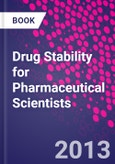Drug Stability for Pharmaceutical Scientists is a clear and easy-to-follow guide on drug degradation in pharmaceutical formulation. This book features valuable content on both aqueous and solid drug solutions, the stability of proteins and peptides, acid-base catalyzed and solvent catalyzed reactions, how drug formulation can influence drug stability, the influence of external factors on reaction rates and much more. Full of examples of real-life formulation problems and step-by-step calculations, this book is the ideal resource for graduate students, as well as scientists in the pharmaceutical and related industries.
Please Note: This is an On Demand product, delivery may take up to 11 working days after payment has been received.
Table of Contents
I. Principles of drug degradation (the solution kinetics and mathematical treatment): 1. Zero, first, second and third order reactions 2. Complex reactions (e.g. reversible reactions, parallel reactions, consecutive reactions, steady state, enzyme kinetics etc.) 3. Effect of temperature (e.g. Arrhenius, Q10-values, Collision theory, Transition state theory, Eyring equation etc.) 4. Effect of pH (Specific acid/base catalysis, pH-rate profiles) 5. Effect of buffer salts (General acid/base catalysis or buffer catalysis) 6. Ionic strength 7. Solvent effects (e.g. dielectric constant) 8. Surface active compounds (micelle effect) 9. Effect of complexation (e.g. cyclodextrins, metal ions and carbohydrates) 10. Effect of light, oxygen and other catalytic compounds. II. Degradation pathways Selected examples of drug degradation with examples and mathematical calculations. 1. Hydrolysis (aspirin, procaine, procainamide, acetaminophen, ß-lactam antibiotics, nitrogen mustards etc.) 2. Oxidation (morphine, epinephrine, vitamin C, vitamin A, hydrocortisone, polyunsaturated fatty acids (autoxidation) etc.; antioxidants) 3. Isomerization and racemization (ephedrine, tetracyclines, pilocarpine, vitamin A, thalidomide, etc.) 4. Photodegradation 5. Polymerization (ß-lactam antibiotics etc.) 6. Decarboxylation and elimination (p-aminosalicylic acid) 7. Dehydration (prostaglandins etc.) III. Drug degradation in semi-solid state 1. Ointments 2. Creams (o/w and w/o emulsions) 3. Gels IV. Drug degradation in solid state 1. Physical stability of drugs (crystallization of amorphous drugs, polymorph transitions, crystal growth, moisture absorption and vapor absorption, nitroglycerine) 2. Chemical stability (hydrolysis (aspirin), etc.) V. Stability of peptide and proteins VI. Stability testing 1. Stability testing during preformulation studies. 2. Stability testing of the final product 3. Regulations of stability testing (including ICH guidelines) Appendix








